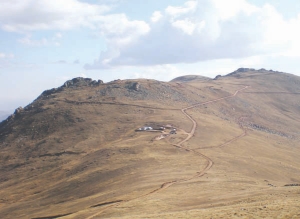The European Bank of Reconstruction and Development (EBRD) will invest $1.6 million to finance Lydian International’s (LYD-T) exploration projects in the Western Balkans.
The investment follows a $1.4- million equity investment by the International Finance Corp. on Jan. 28, which raised IFC’s stake in Lydian to 18% from 12.9%.
Following the private placement, the EBRD will own 8.1% of Lydian on a non-diluted basis.
EBRD’s placement is for a total of 3.81 million shares and will be priced at Lydian’s recent market price of 42¢ per share.
Each share of Lydian that EBRD receives will be accompanied by a half warrant with a three-year exercise period at a price of 53¢, plus another half warrant with a five-year exercise period, exercisable at 59¢.
“The investment comes at a time of turbulent markets when refinancing- risk is a dominant factor undermining investor confidence in the resource sector,” said Lydian president and chief executive Tim Coughlin, in a statement. He added that the financing from both the EBRD and the IFC would be enough to sustain Lydian’s projects this year.
Coughlin noted that having EBRD and IFC as committed long-term partners gives the company “continued access to finance, influential in-country support, and advice in managing regulatory, environmental and social risks.”
The EBRD’s mandate is to build market economies and democracies in countries from central Europe to central Asia. The bank was set up in 1991 at a time when communism was unravelling in central and Eastern Europe, and countries in the former Soviet Union needed help to grow a private sector. The bank is funded by 61 member countries.
“People shouldn’t get the impression that the IFC and the EBRD are at the bottom of the list for investment, they should be at the top of the list,” Coughlin said by telephone from the United Kingdom. But he concedes that getting funding from the two institutions “isn’t easy” and comes with very strict compliance and corporate governance requirements.
“Some companies can’t be bothered with all the compliance that you are required to get in an IFC or EBRD investment,” he says. “Their biggest risk is management risk and they want to make sure everyone is squeaky clean. So we had a big investigation by the men in dark glasses. They also come to your projects a couple of times a year to make sure the social and environmental work is on track.”
That sort of regulation isn’t every-one’s cup of tea but it’s a perfect fit for Lydian, Coughlin says. “In places like we’re in, with mixed reputations, any guidance is greatly appreciated.”
Incorporated in Jersey in 2005, Lydian is focused on Eastern Europe, developing advanced precious and base metal projects in Armenia and in Kosovo.
Its flagship projects are Amulsar in Armenia (gold) and Drazhnje in Kosovo (zinc, lead, silver and gold).
Lydian also has a pipeline of promising exploration projects for gold and base metals in the Balkans region and operates a 50-50 joint venture with Newmont Overseas Exploration, a subsidiary of Newmont Mining (NMC-T, NEM-N) in the south Caucasus region (gold and copper).
The company’s two largest shareholders are Newmont Mineral Holdings (12.9%), owned by Newmont Mining, and the IFC, part of the World Bank Group.
The junior explorer’s Amulsar licence extends across a region of high-sulphidation, epithermal-type gold mineralization in central Armenia. Lydian discovered the property in 2006.
Amulsar forms part of Lydian’s Caucasus joint venture with Newmont Overseas Exploration.
A further 13,000 metres of diamond and reverse-circulation drilling have just been completed at the project.
This year Lydian is planning a 10,000-to 15,000-metre drill program to define a resource by the end of 2009.
“Amulsar has eclipsed the other projects at the moment,” Coughlin says. “In this market with gold being the only real commodity that people seem to have any appetite for, Amulsar is at the top of our list.”
The Drazhnje project, about 36 km from the capital of Prishtina in Kosovo, is Lydian’s other major project.
Historic exploration activities identified a number of variably exposed northwest-trending massive sulphide bodies but exploration on the project was discontinued.
At presstime Lydian was trading at 37¢ per share in a 52-week trading range of 11-70¢.
The junior has 39.9 million shares outstanding.


Be the first to comment on "‘Squeaky Clean’ Lydian Gets Help From EBRD, IFC"